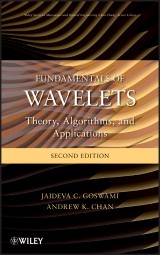Details

Fundamentals of Wavelets
Theory, Algorithms, and ApplicationsWiley Series in Microwave and Optical Engineering, Band 233 2. Aufl.
|
122,99 € |
|
| Verlag: | Wiley |
| Format: | EPUB |
| Veröffentl.: | 08.03.2011 |
| ISBN/EAN: | 9780470934647 |
| Sprache: | englisch |
| Anzahl Seiten: | 382 |
DRM-geschütztes eBook, Sie benötigen z.B. Adobe Digital Editions und eine Adobe ID zum Lesen.
Beschreibungen
Most existing books on wavelets are either too mathematical or they focus on too narrow a specialty. This book provides a thorough treatment of the subject from an engineering point of view. It is a one-stop source of theory, algorithms, applications, and computer codes related to wavelets. This second edition has been updated by the addition of: <ul> <li>a section on "Other Wavelets" that describes curvelets, ridgelets, lifting wavelets, etc </li> <li>a section on lifting algorithms </li> <li>Sections on Edge Detection and Geophysical Applications </li> <li>Section on Multiresolution Time Domain Method (MRTD) and on Inverse problems </li> </ul>
1.What is this book all about? <p>2. Mathematical Preliminary.</p> <p>2.1 Linear Spaces.</p> <p>2.2 Vectors and Vector Spaces.</p> <p>2.3 Basis Functions, Orthogonality and Biothogonality.</p> <p>2.4 Local Basis and Riesz Basis.</p> <p>2.5 Discrete Linear Normed Space.</p> <p>2.6 Approximation by Orthogonal Projection.</p> <p>2.7 Matrix Algebra and Linear Transformation.</p> <p>2.8 Digital Signals.</p> <p>2.9 Exercises.</p> <p>2.10 References.</p> <p>3. Fourier Analysis.</p> <p>3.1 Fourier Series.</p> <p>3.2 Rectified Sine Wave.</p> <p>3.3 Fourier Transform.</p> <p>3.4 Properties of Fourier Transform.</p> <p>3.5 Examples of Fourier Transform.</p> <p>3.6 Poisson’s Sum and Partition of ZUnity.</p> <p>3.7 Sampling Theorem.</p> <p>3.8 Partial Sum and Gibb’s Phenomenon.</p> <p>3.9 Fourier Analysis of Discrete-Time Signals.</p> <p>3.10 Discrete Fourier Transform (DFT).</p> <p>3.11 Exercise.</p> <p>3.12 References.</p> <p>4. Time-Frequency Analysis.</p> <p>4.1 Window Function.</p> <p>4.2 Short-Time Fourier Transform.</p> <p>4.3 Discrete Short-Time Fourier Transform.</p> <p>4.4 Discrete Gabor Representation.</p> <p>4.5 Continuous Wavelet Transform.</p> <p>4.6 Discrete Wavelet Transform.</p> <p>4.7 Wavelet Series.</p> <p>4.8 Interpretations of the Time-Frequency Plot.</p> <p>4.9 Wigner-Ville Distribution.</p> <p>4.10 Properties of Wigner-Ville Distribution.</p> <p>4.11 Quadratic Superposition Principle.</p> <p>4.12 Ambiguity Function.</p> <p>4.13 Exercise.</p> <p>4.14 Computer Programs.</p> <p>4.15 References.</p> <p>5. Multiresolution Anaylsis.</p> <p>5.1 Multiresolution Spaces.</p> <p>5.2 Orthogonal, Biothogonal, and Semiorthogonal Decomposition.</p> <p>5.3 Two-Scale Relations.</p> <p>5.4 Decomposition Relation.</p> <p>5.5 Spline Functions and Properties.</p> <p>5.6 Mapping a Function into MRA Space.</p> <p>5.7 Exercise.</p> <p>5.8 Computer Programs.</p> <p>5.9 References.</p> <p>6. Construction of Wavelets.</p> <p>6.1 Necessary Ingredients for Wavelet Construction.</p> <p>6.2 Construction of Semiorthogonal Spline Wavelets.</p> <p>6.3 Construction of Orthonormal Wavelets.</p> <p>6.4 Orthonormal Scaling Functions.</p> <p>6.5 Construction of Biothogonal Wavelets.</p> <p>6.6 Graphical Display of Wavelet.</p> <p>6.7 Exercise.</p> <p>6.8 Computer Programs.</p> <p>6.9 References.</p> <p>7. DWT and Filter Bank Algorithms.</p> <p>7.1 Decimation and Interpolation.</p> <p>7.2 Signal Representation in the Approximation Subspace.</p> <p>7.3 Wavelet Decomposition Algorithm.</p> <p>7.4 Reconstruction Algorithm.</p> <p>7.5 Change of Bases.</p> <p>7.6 Signal Reconstruction in Semiorthogonal Subspaces.</p> <p>7.7 Examples.</p> <p>7.8 Two-Channel Perfect Reconstruction Filter Bank.</p> <p>7.9 Polyphase Representation for Filter Banks.</p> <p>7.10 Comments on DWT and PR Filter Banks.</p> <p>7.11 Exercise.</p> <p>7.12 Computer Program.</p> <p>7.13 References.</p> <p>8. Special Topics in Wavelets and Algorithms.</p> <p>8.1 Fast Integral Wavelet Transform.</p> <p>8.2 Ridgelet Transform.</p> <p>8.3 Curvelet Transform.</p> <p>8.4 Complex Wavelets.</p> <p>8.5 Lifting Wavelet transform.</p> <p>8.6 References.</p> <p>9. Digital Signal Processing Applications.</p> <p>9.1 Wavelet Packet.</p> <p>9.2 Wavelet-Packet Algorithms.</p> <p>9.3 Thresholding.</p> <p>9.4 Interference Suppression.</p> <p>9.5 Faulty Bearing Signature Identification.</p> <p>9.6 Two-Dimensional Wavelets and Wavelet Packets.</p> <p>9.7 Edge Detection.</p> <p>9.8 Image Compression.</p> <p>9.9 Microcalcification Cluster Detection. </p>
"This book provides a thorough treatment of wavelet theory and is very convenient for graduate students and researchers in electrical engineering, physics, and applied mathematics." (Zentralblatt MATH, 2011) <p> </p>
<p>Jaideva C. Goswami, PhD, is an Engineering Advisor at Schlumberger in Sugarland, Texas. He is also a former professor of Electronics and Communication Engineering at the Indian Institute of Technology, Kharagpur. Dr. Goswami has taught several short courses on wavelets and contributed to the Wiley Encyclopedia of Electrical and Electronics Engineering as well as Wiley Encyclopedia of RF and Microwave Engineering. He has many research papers and patents to his credit, and is a Fellow of IEEE.</p> <p>Andrew K. Chan, PhD, is on the faculty of Texas A&M University and is the coauthor of Wavelets in a Box and Wavelet Toolware. He is a Life Fellow of IEEE.</p>
<p>Now updated—the authoritative treatment of wavelets from an engineering point of view</p> <p>Wavelet theory originated from research activities in many areas of science and engineering. As a result, it finds applications in a wide range of practical problems. Wavelet techniques are specifically suited for nonstationary signals for which classic Fourier methods are ineffective. Developments over the last decade have led to many new wavelet applications such as image compression, turbulence, human vision, radar, and earthquake prediction.</p> <p>Based on courses taught by the authors at Texas A&M University as well as related conferences, Fundamentals of Wavelets is a textbook offering an up-to-date engineering approach to wavelet theory. It balances a discussion of wavelet theory and algorithms with its far-ranging practical applications in signal processing, image processing, geophysical applications, electromagnetic wave scattering, and boundary value problems.</p> <p>In a clear, progressive format, the book describes:</p> <ul> <li> <p>Basic concepts of linear algebra, Fourier analysis, and discrete signal analysis</p> </li> <li> <p>Theoretical aspects of time-frequency analysis and multiresolution analysis</p> </li> <li> <p>Construction and properties of various real and complex wavelets and curvelets</p> </li> <li> <p>Algorithms for computing wavelet transformations</p> </li> <li> <p>Applications to signal processing, geophysical applications, and boundary value problems</p> </li> </ul> <p>This Second Edition features new sections on curvelets, ridgelets, and lifting wavelet transforms; complex wavelets; edge detection and geophysical applications; and multiresolution time domain method. It covers time-frequency analysis techniques such as short-time Fourier transform and Wigner-Ville distribution. Concluding chapters present interesting applications of wavelets to signal processing and boundary value problems. Numerous examples and figures are also included along with simple matlab® programs.</p> <p>Fundamentals of Wavelets is an essential introduction to wavelet theory for students and professionals alike in a practical, real-world engineering context. It is ideally suited for senior and graduate students in electrical engineering, physics, and mathematics; research engineers and physicists; and design and software engineers in the telecommunications and signal processing industries.</p>


















